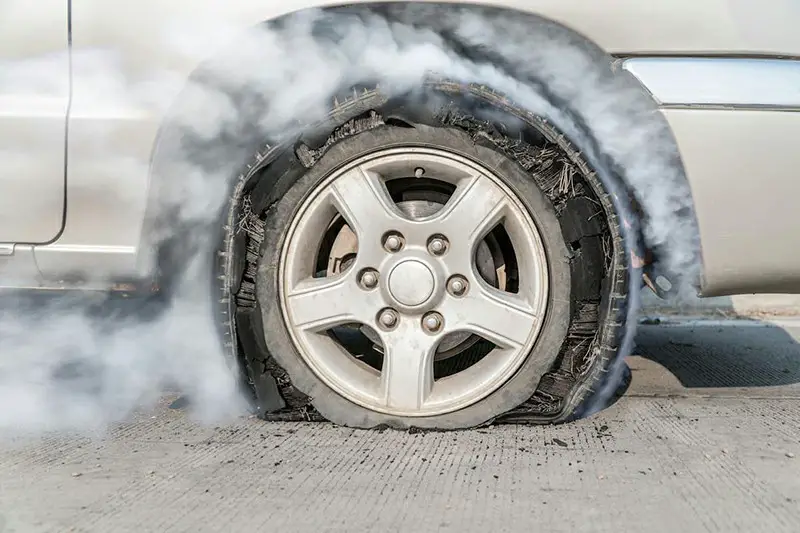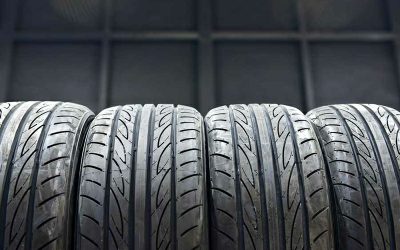What Factors Affect Tire Pressure?
Aside from a nail creating a hole or other pointed/sharp object puncturing the tire, two factors directly affect air amount inside the tire: air temperature and gradual (slow) leak.
Slow Leak

So, what is a slow leak?
It is defined similarly as a small hole or puncture in a tire. However, unlike a puncture that results in a flat tire during a short period of time, the gradual leak usually takes considerably longer.
This situation could be caused by an incorrect seal seen between tire and wheel while installing new tires, cracked tires, a defective air valve, damaged wheels, or a recent puncture that was improperly mended.
Air Temperature
The second aspect is air temperature. It is considered the most prevalent variable that influences tire pressure.
Air expands as it warms. And it contracts as it cools. This rule decodes the situation when the drivers start the engine in the cold morning and see the TPMS system indicating the air pressure is in low status.
The scenario explains why tire makers and mechanics advocate filling the tire once it is cool.
What Tire Pressure Is Too Low?
Technically, it is based on what the PSI tells us.
Any PSI – the number of pounds per square inch of air – below the specified threshold from manufacture is considered too low.
For example, a vehicle requires the tire inflation indicator to be 35 PSI, so the pressure of 31 or 32 pounds PSI is seen as underinflated. Before the Tire Pressure Monitoring System indicator lights up, several manufacturers permit up to 25% air loss. A tire with a PSI of 20 or less is usually deemed flat.
How To Test Low Tire Pressure
Let’s check the method to test the pressure of your vehicle to see whether it is subpar. There are three steps:
- The first step is looking for the manufacturer’s recommended air amount inside the tire for your companion! You can find it at the driver’s doorpost, called car manual!
- Next, examine the air pressure of your tire! There are some gauges, which are called tire-pressure devices. They are diverse in choice: digital, stick, or dial. Choose the one that fits you the most and start the journey!
- Finally, you start to compare the number on the device to the manufacturer’s recommendations. For a precise reading, the tires must be “cold.” Therefore, perform the measurement early in the dawn. Do it as the first and foremost thing you need to do in days, or you must wait for at least a few hours (about 3 hours) after driving.
What Are The Signs Of Low Tire Pressure?
Flapping Sound
The first signal is the sound and noise when you are on the road!
When you are driving, you hear the “womp womp noise” or flapping sound. This first hint indicates that you should check whether your vehicle reaches the lowest tire pressure.
When a deflated tire slaps against the pavement, it makes a noise. This is a common initial indicator of a flat tire. As a result, pull over right away and check your air amount inside the tire.
Driving Feel

The most apparent method to detect is driving and steering sensation, particularly if you have owned the vehicle for a time and know how to feel when driving it.
Vehicles are designed to perform in specific ways during optimal circumstances. And low air amount inside the tire has a detrimental impact on these parameters.
This insufficient status can cause sloppy handling, tugging to one side, trouble maintaining the vehicle going in a straight path, inability to steer properly, and an overall unsettled ride.
All this is amplified in bad weather, and also, in extreme cases, the car can lose its traction.
Premature Tire Wear
Another symptom is tires are being worn unevenly or prematurely. A deflated tire will impair down on every side, with the vehicle’s tread staying thicker at the center instead of having a consistent tread all over the tire.
Fuel Economy
When properly inflated, you can get the highest achievement of fuel economy through balancing grip and surface area.
Tires can weigh down the vehicle. Akin to kicking a full ball rather than an underinflated ball, the engine has to work even harder to move it.
Treadwear is unequal, with the sides of the tires wearing out first. Braking’s performance is subpar. Because of the rise in rolling resistance and vehicle drag, there is an equal increase in energy consumption.
When driving, a tiny quantity of deflation of the tires may not always be noticeable. However, you can find a big difference when your car (or any vehicle you have) is driving at high velocities.
According to some reports, underinflated tires can result in the loss of about 3 miles to the gallon. The chance of it occurring increases significantly when more than one tire is underinflated at the same time!
Please do not forget to check the air amount inside the tire when you see abnormal fuel consumption!
Stopping Distance
The last indication is the longer stopping distance than usual. Low air amount inside the tire can significantly reduce stopping distances.
A careful driver will detect the abnormality easier than the ordinary commuter because it is not usually the most evident symptom of underinflated tires.
The sign will become even clearer in rainy or snowy weather situations. Under these circumstances, the issue becomes considerably worse, and you can see the clear signal of the stopping distance.
What Happens If My Tire Pressure Is Too Low?
Blowouts

How It Happens
The most serious result is tire blowouts induced by a compromised tire structure or excessive wear. Too low air pressure/underinflation and the car’s weight and large tire loads might lead one or even more tire parts to break unexpectedly.
In detail, the sidewalls bend more, causing heat to pile up inside the tire. If the hotness/overheating is severe enough, a part of the tire can split from its body. And a blowout is on its way if the situation occurs suddenly.
There’s a greater likelihood of the situation happening if you drive at high speeds on the highway. Otherwise, it has lower risk as the tire turns slowly and doesn’t accumulate too much heat. However, it does not mean lower speed plus low air amount inside the tire will be a great pair! There are still dangers to be aware of.
The lower air pressure the tire has, the more soft the tire is, and it is much more easily pierced by a pothole’s jagged point.
The majority of blowouts come without notice, so those sudden events can be fatal.
How To Handle
It’s critical to remain calm if your automobile experiences a blowout. The loud bang might panic you, accompanied by an abrupt jerk from one side and another.
To prevent any accidents, grip the steering wheel hard, apply the throttle briefly to settle and rebalance the vehicle. Then, drive to the roadside and let it steadily slow down on its own.
Slowly apply the brake and bring the car to a complete stop once its speed drops to around 20-30 kilometers per hour.
Losing Control
Technically, driving with an under/low inflated air amount inside the tire vehicle affects a vehicle’s steering and handling, as previously stated. Also, terrible weather situations can exacerbate these concerns.
When a vehicle’s air amount inside the tire is too low, abrupt losing control can occur at any moment. Thus, any traction loss when traveling at high speeds can result in a crash, even though no indicators of abnormal handling were apparent previously.
Numerous thousand crashes happen each year as a result of the problem. Hence, don’t underestimate it!
Conclusion
Air amount inside the tire below the threshold seems to be a regular occurrence. However, it has become one of the most dangerous.
Any driver should check the tire pressure at least once a month to minimize early tire wear, longer braking distances, improper steering, and incidents.
Temperature variations may also affect the pressure inside the tires. For every 10 degrees that the temperature drops, the air amount inside the tire drops one pound.
Consequently, the disparity from summer to winter peaks and valleys can cause considerable loss in tire pressure. This, again, backs up why you should check and take note of air amount inside the tire numbers periodically.
You might also like these articles:








